There are few things more satisfying than making your own chicken stock. Vastly superior to anything you can buy in a store, homemade chicken stock is not only cost-effective, but using it in any recipe that calls for stock will immediately improve its flavor.
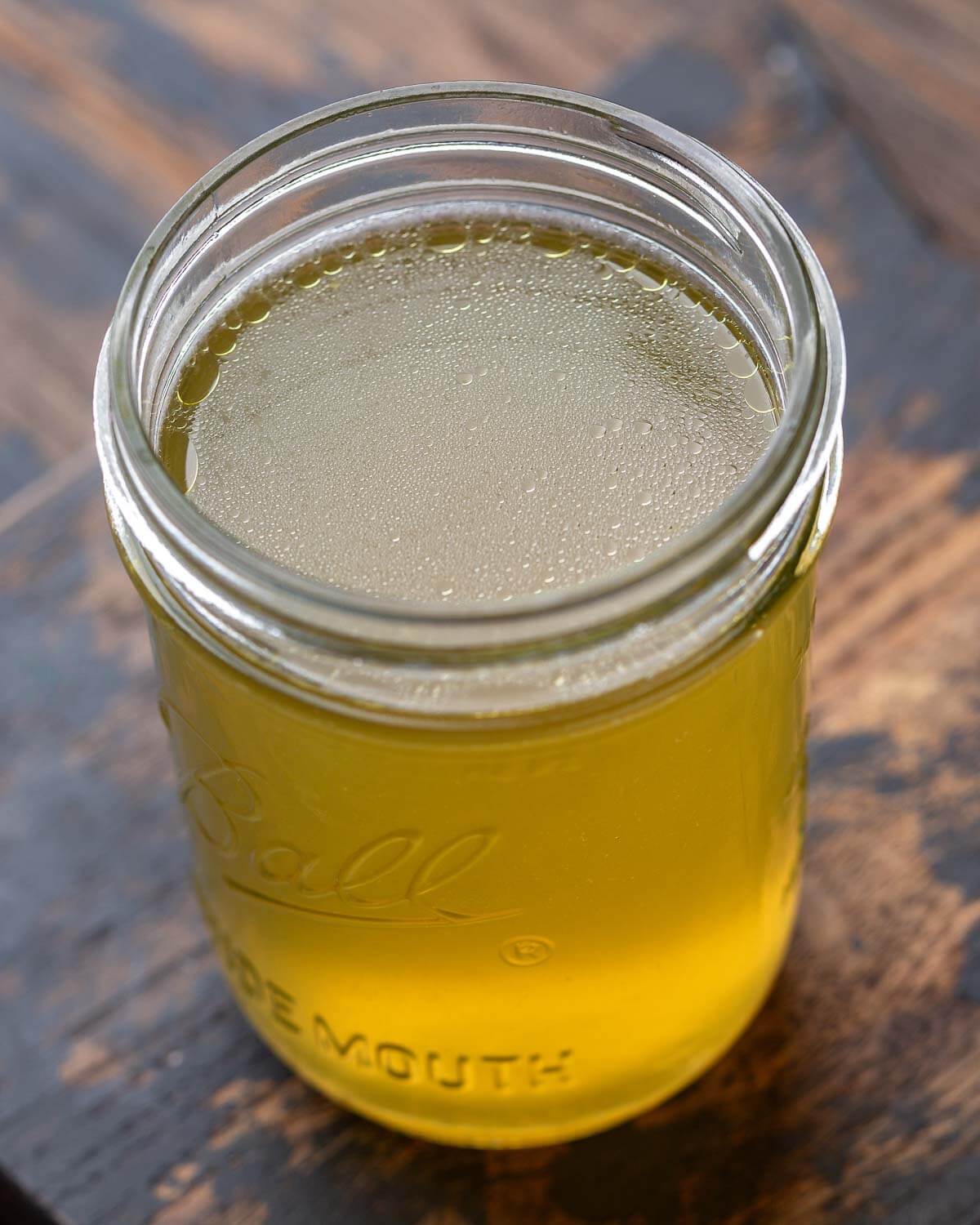
This post may contain affiliate links. Our disclosure policy.
I’m often asked, “Jim, what can I do to make my food taste as good as (or better than) a restaurant’s?”.
My answer is always “start with homemade stock”.
Homemade stock, whether beef stock or chicken stock will always be better than anything you can buy in a store.
While making your own chicken stock does take some time, you’ll soon realize it’s budget-friendly and since you’re making a lot at one time, you’ll have plenty to use anytime a recipe calls for stock.
Chicken stock (or beef stock) can be used in almost every soup or stew recipe but is also used in many other dishes, such as chicken Francese, chicken saltimbocca, and chicken Fricassee.
It lays the foundation for so many recipes and making it from scratch gives you the best possible start!
Table of Contents
Recipe Ingredients
All ingredients for this recipe are shown in the pic below and special notes are made in this bulleted list to assist you.
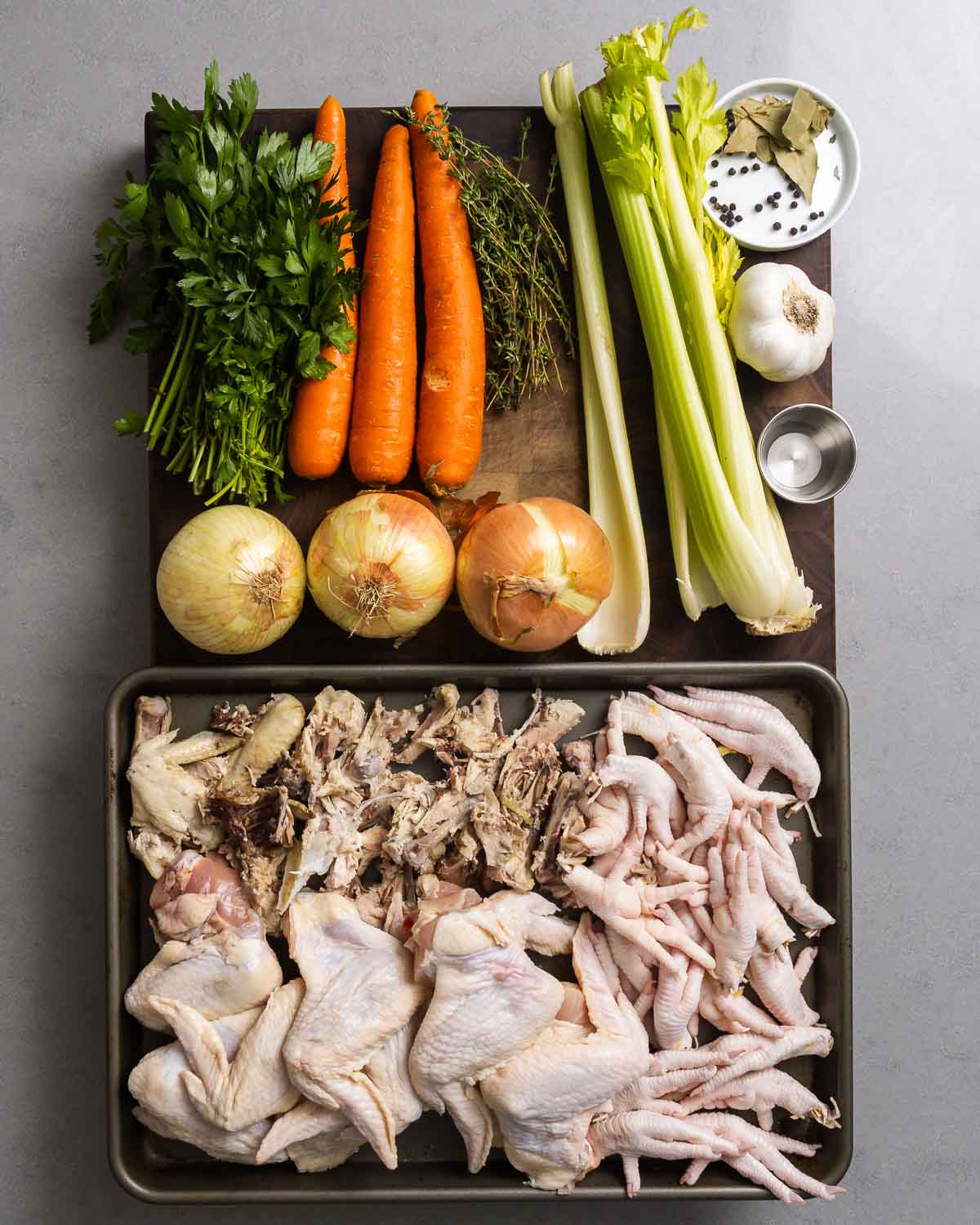
All ingredients for this recipe are shown in the pic below and special notes are made in this bulleted list to assist you.
- Chicken bones. The backbone of the chicken is excellent for stock. If you buy a whole chicken and use its parts for dishes like Italian baked chicken and potatoes and chicken vesuvio, save the back and use it here. You can also use wings or chicken feet (these both work really well!), or the entire frame of the chicken (the carcass). You’ll need 8 pounds worth of bones so you can either buy them all at once or accumulate them over time and store them in the freezer until you have 8 pounds worth.
- Veggies. Chicken stock is almost always flavored with carrots, celery, and onion. There’s no need to finely dice or chop these since they’re simply being used for flavor. Simply cut into large chunks and you’re set.
- Herbs. Fresh thyme, parsley, bay leaves, and peppercorn add another layer of flavor.
- White vinegar. Acid will help break down the bones and collagen and speed up the formation of gelatin resulting in a richer stock.
See the recipe card for full information on ingredients and quantities.
Want To Save This Recipe?
How to make it
Each number corresponds to the numbered written steps below.
- Cut 3 large carrots and 6 ribs of celery, leaves included, into 3-inch pieces. Slice 3 medium yellow onions in half (the skin can be left on) (Photo #1).
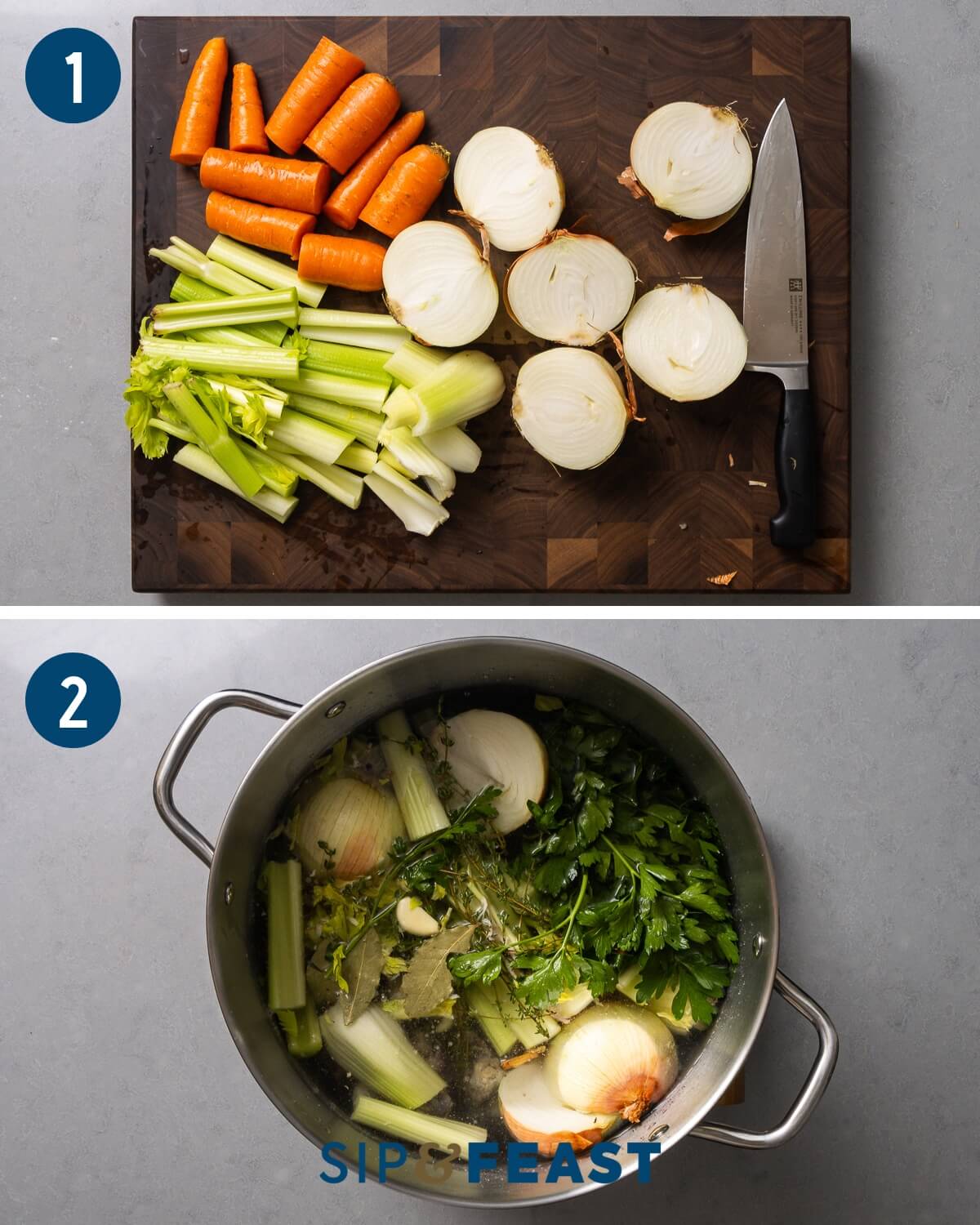
- Add the cut vegetables to a large (16-quart or larger) stock pot along with 8 pounds of chicken bones (wings, chicken feet, backbones, etc.), 8 cloves of garlic, 4 dried bay leaves, 1 bunch of flat-leaf parsley, 25 peppercorns, 20 sprigs of fresh thyme, and 1 tablespoon of vinegar. Add just enough water to cover all of the ingredients and bring to a boil over medium-high heat (Photo #2).
- Once boiling, skim the scum from the top with a large flat spoon or ladle and reduce the heat to very low and allow the stock to gently simmer. You really want just a small bubble or two. Keep the heat very low (Photo #3).
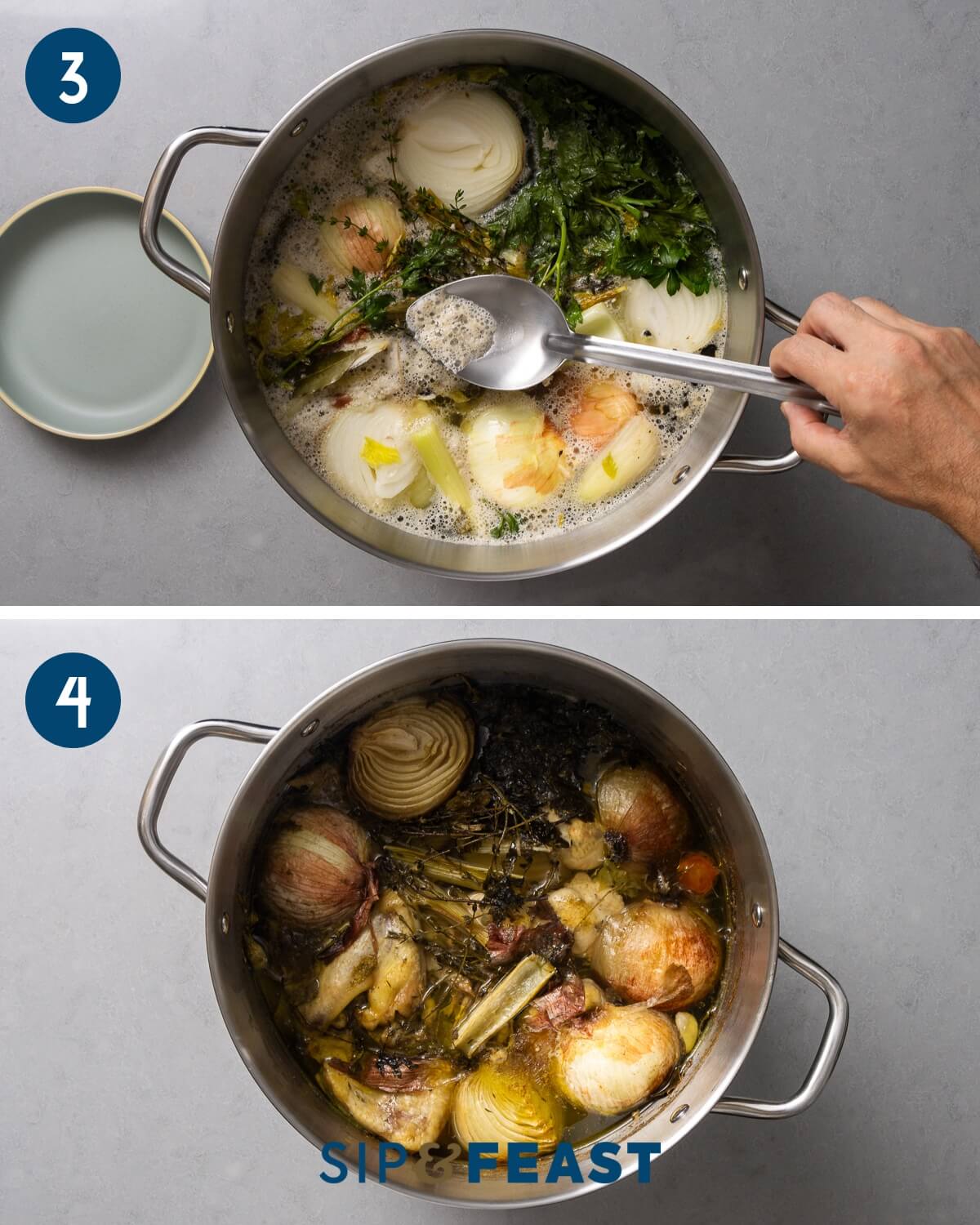
- Allow the stock to simmer on low for 6-8 hours skimming the scum every 45-60 minutes, taking care to not stir or agitate the stock. After 6-8 hours, turn off the heat. Note: 6 hours tends to be the mark where your stock will have extracted most of the flavors but I often just let it go for 8 (Photo #4).
- Place a large bowl beside the stock pot and using a pasta spider, strain the stock by gently removing the spent vegetables and bones (Photo #5).
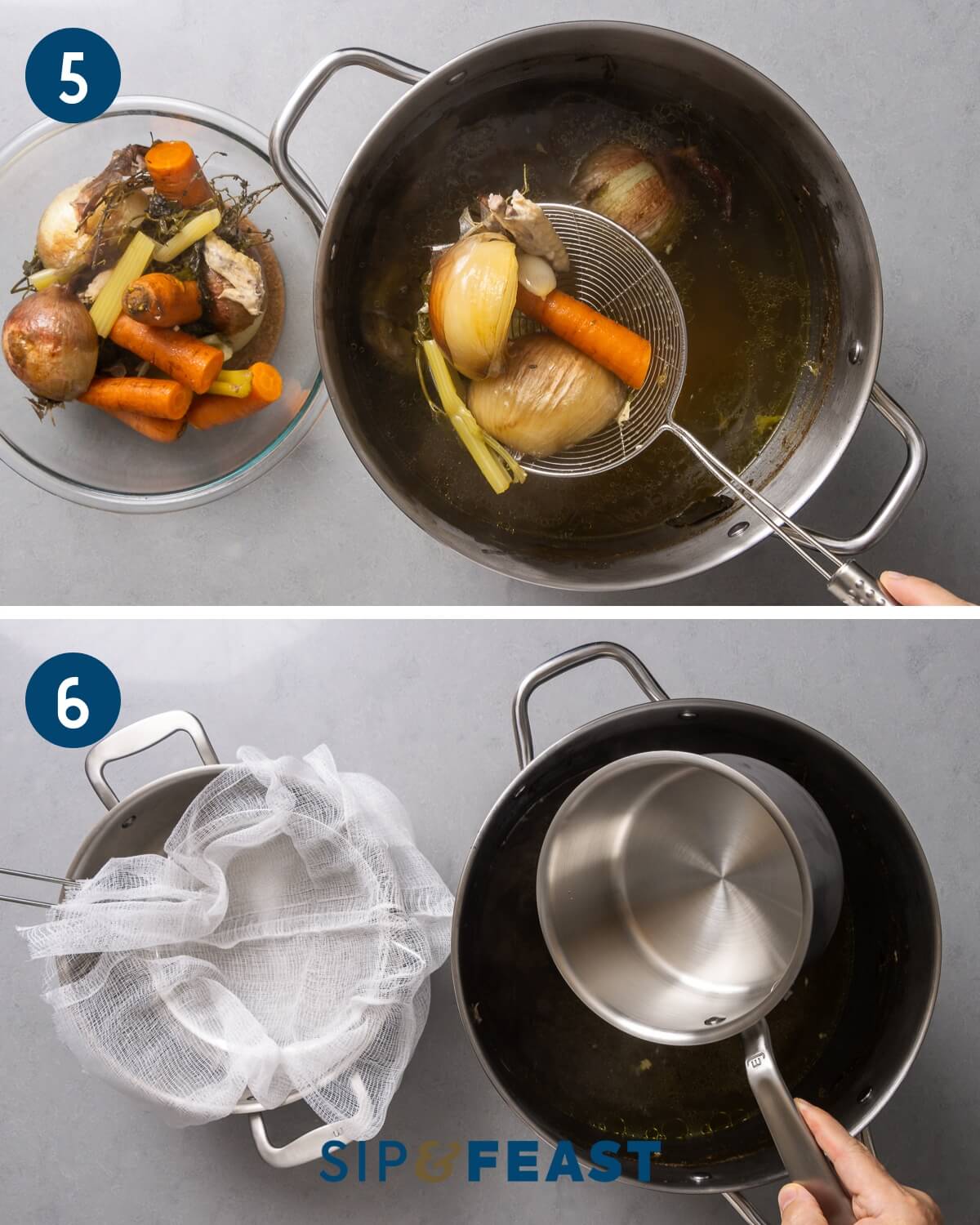
- Place a large pot fitted with a strainer and cheesecloth beside the stock pot. If you have a fine mesh seive, use that instead (Photo #6).
- Begin to pour or use a small pot with a long handle to ladle the stock through the cheesecloth/colander combo (Photo #7). Once finished, you should have approximately 6 quarts of stock. If you find there’s substantially more than that, simply reduce the stock in the pot by boiling it until it reduces to roughly 6 quarts.
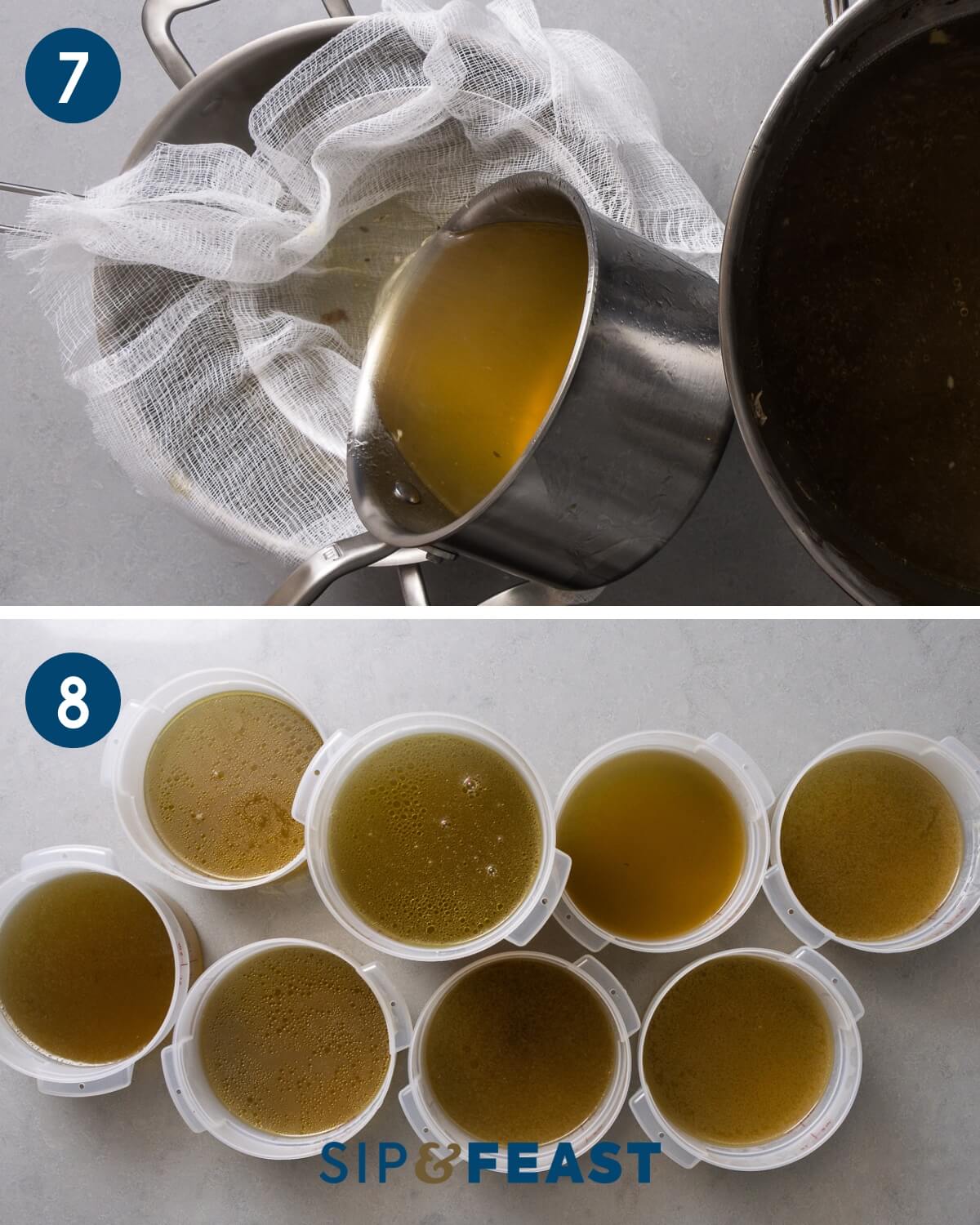
- Allow the stock to cool, then divide it into storage containers. After refrigerating or freezing, the solidified fat will rise to the top of each container which will help protect the flavor of the stock. The fat can be saved for another use or easily removed and discarded right before using (Photo #8).
Storing chicken stock
The beauty of homemade chicken stock is that you can store it for use on a weekly or even daily basis.
I recommend storing the stock in small containers, preferably 1 quart, however, smaller amounts are great too, especially when only a little stock is needed for a recipe.
One way to store smaller quantities of chicken stock is to use ice cube trays (the large ones to make fancy ice cubes for cocktails work great) or other small containers.
Alternatively, you can ladle the chicken stock onto a baking sheet, freeze it, then use a knife to divide the frozen stock into the desired portions. This is actually a very easy and efficient way to portion stock. A baking dish works well too.
Homemade chicken stock can be stored in the freezer for up to 6 months, and in the fridge for up to 5 days.
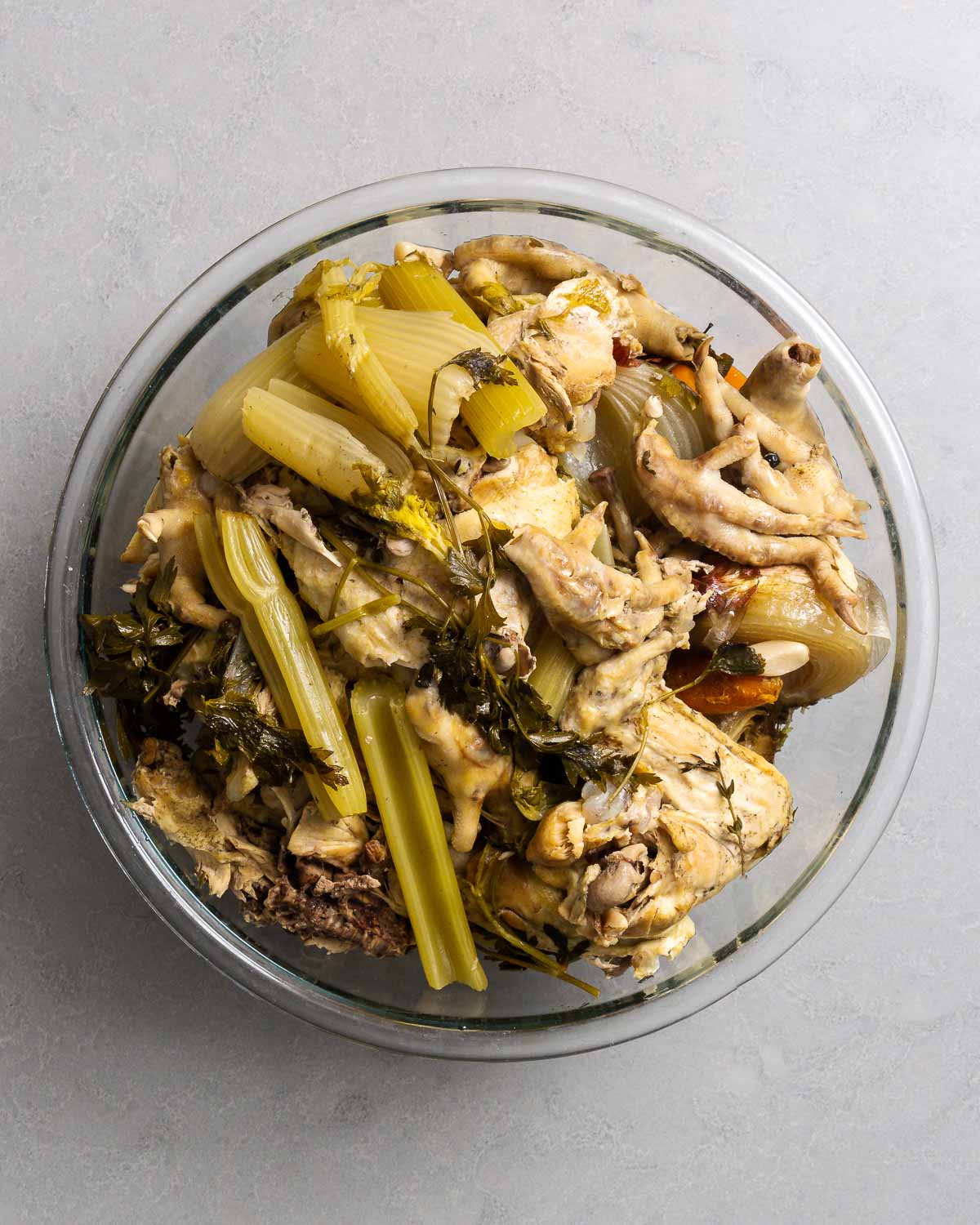
Top tips
- Don’t stir. Stirring the stock or agitating the bones will yield a cloudy stock. Just let the stock simmer for 8 hours, strain the spent ingredients, then strain the stock through a cheesecloth-lined sieve.
- Salt. I do not recommend salting homemade chicken stock. Rather salt accordingly when adding the stock to the recipe it’s being used for. This is one of the key benefits of making homemade stock since almost all boxed stocks that are labeled as low-sodium still contain more salt than you’d like.
- Reuse the bones! After making 6 quarts of stock you may not want to do much else, however, reusing the bones (toss the aromatics and use new ones) to make a second stock, or remouillage, is a great way to stretch your money even further.
Chicken stock is made from chicken bones and has a rich, gelatinous mouthfeel thanks to the marrow and collagen. Chicken broth (pollo di brodo) is typically made from chicken meat (and bones) and will have a lighter texture. Both broths and stocks are also often flavored with root vegetables and herbs.
A remouillage is a second stock made from the strained wet bones used for a previous stock. To make a remouillage you’d simply add new vegetables and fresh water to the bones. It will not be as rich and flavorful as the original stock, but is a great way to get the most bang for your buck.
Chicken feet add loads of body and richness making the stock extra gelatinous while the wings add a ton of flavor. The combination of both of these makes the perfect chicken stock. If you’re apprehensive about using chicken feet, make sure to still use wings since they really are a game changer in regards to flavor.
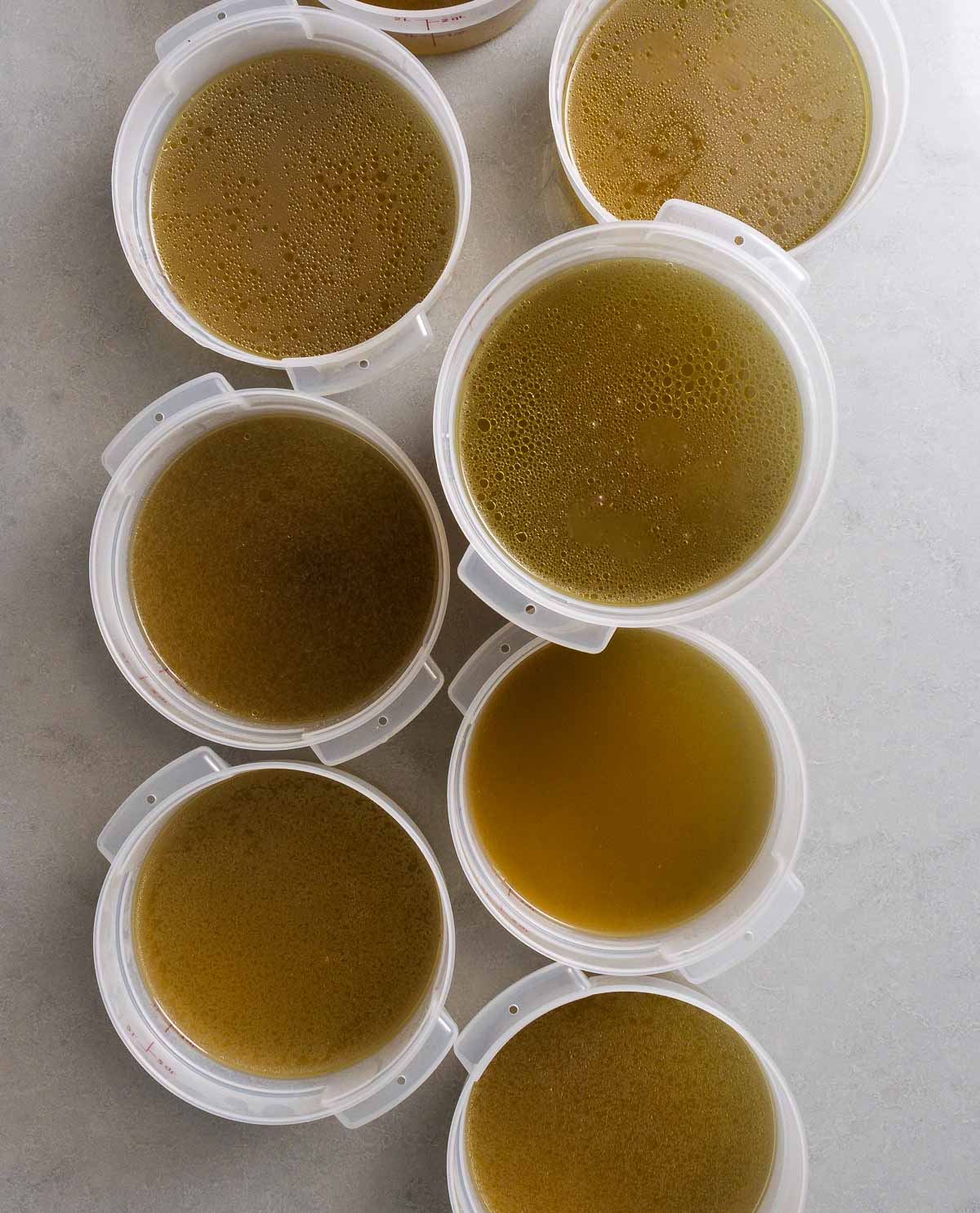
Our favorite ways to use chicken stock
While there are literally hundreds of recipes that include chicken stock as an ingredient, here are a few of our most popular.
- Tuscan white bean soup – with roasted garlic, pancetta, veggies, and herbs.
- Escarole and Bean soup – with potatoes, pancetta, and cannellini beans.
- chicken piccata – the chicken stock really elevates the flavors of the chicken, capers, and lemon.
If you’ve enjoyed this chicken stock recipe or any recipe on this site, give it a 5-star rating and tell us about it in the comments below.
We strive to satisfy a number of learning styles. If you are someone who prefers to learn by watching, you can find most of our recipes on YouTube and our Facebook Page.
Chicken Stock
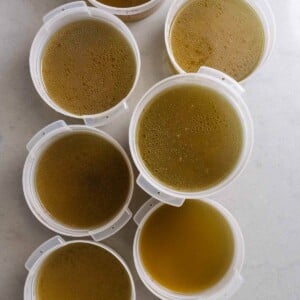
Ingredients
- 8 pounds chicken backbones or a combination of wings and chicken feet see below
- 3 large carrots cut into 3-inch pieces
- 6 ribs celery cut into 3-inch pieces, use leaves too
- 3 medium yellow onion cut in half
- 8 cloves garlic
- 4 dry bay leaves
- 1 bunch flat leaf parsley
- 25 peppercorns
- 20 sprigs fresh thyme
- 1 tablespoon white vinegar
- water enough to fill above all ingredients
Want To Save This Recipe?
Instructions
Simmer the stock
- Add all of the ingredients into at least a 16-quart stockpot and pack them down with a wooden spoon. Add enough water to just cover all of the ingredients. Bring to a boil over medium-high heat.
- Once boiling skim the scum from the top with a large flat spoon or ladle. Turn the heat down to a very low level where the stock is very gently simmering.
- Simmer for 8 hours, skimming the scum every 45-60 minutes.
Straining the stock
- After 8 hours turn off the heat and strain the stock. Place a sieve or colander over an empty pot and line it with cheesecloth or coffee filters.
- First, gently remove most of the bones and vegetables from the pot then pour or ladle the stock (a small pot with a long handle works well as a big ladle) into the cheesecloth-lined strainer.
- You should be left with approximately 6 quarts of stock. If you have substantially more than that simply reduce the stock in a pot before storing.
- Let the stock cool then divide into storage containers. After refrigerating or freezing the solidified fat will be at the top of each container, protecting the flavor of the stock. The fat can be saved for another use or easily removed and discarded right before using. See below for storage notes.
Notes
- This recipe makes approximately 5-6 quarts of chicken stock. If you have substantially more than that, the stock will be too weak. Pour the stock into a clean pot and cook over medium-high heat to reduce the stock down to 6 quarts before storing.
- We recommend no salt in stocks. Salt accordingly, when using stocks to make your recipe.
- Storing in smaller containers is recommended. 1-quart containers are how we typically store stock. But smaller amounts can be stored in ice cube trays or other smaller containers.
- Don’t worry when the stock turns to jelly in the fridge. That is perfectly normal, and good. It means you extracted the gelatin from the chicken bones.
- The stock can be stored in the fridge for up to 5 days or in the freezer for up to 6 months.
- It’s best to leave the fat cap during storage, since it provides a protective seal at the top of the container which locks in the flavor. Simply remove the fat cap upon use, or save the fat for another use.
Nutrition
Nutrition information is automatically calculated, so should only be used as an approximation.
Follow Me







great stock
So happy you enjoyed, Janet!
Jim, you’re the best. I’ve never had a fail with your recipes.
Keep up the good work.
Maurice
Thanks so much, Maurice!
Sounds easy….the chicken feet kind of give me the creeps, but I will be using thighs!! Thanks so much.
Do you have a cookbook for sale?
Hi Michelle, thank you for your interest! We’re currently working on a cookbook. We’ll announce more via email and our social channels as we have more information!
I just learned some very valuable information
Dear Tara, dear James,
I am sitting in my kitchen early Sunday morning after simmering my stock over night. Wasn’t producing anymore scum before I went to bed. I haven’t looked it up, but I guess the recipe is just how you do it, but what makes this recipe so special for me are your comments at the side … “usually 6 but I choose 8 hrs” … “why stirring is a bad idea”…”what this or that bone is adding to the flavour” and so forth. I experimented with many of your recipes (devil eggs, tuscan soup, Swedish meatballs, wedding soup and many more) over the last few month and all these “tips on the side” improved the overall quality of my cooking so much. Of course the recipes are awesome, but I learned so much more about cooking by executing and looking at the videos to see how YOU are doing them, its amazing. I like the videos as much as the “written” ones. While I think the videos are more entertaining, I use the written ones actually to work with.
What I wish to have?
– The possibility to “personalize” my website experience by creating my “own cookbook”. I’d love to add and remove recipes to a virtual cookbook. For now I am printing them on paper and keep them in the kitchen somewhere.
– Visit you and have a three-day cooking course with other enthusiasts to learn to cut, cook, clean and get some overall tips on equipment. 🙂
This comment is a bit off topic, I know, but I didn’t know where else to put it.
Will now continue to put the stock into containers… I think the 8 hrs have passed.
kind regards
Gilles
Hi Gilles, thanks for the comment – we truly appreciate your feedback and are so happy you’re enjoying the recipes and tips. Thanks for sharing your “wishes” with us. The personalized experience is a great suggestions, and the in person cooking course is something we’ve discussed and want to do, but we don’t have a time line for that just yet. Hope you enjoy the stock and continue to enjoy the recipes and videos!
I meant beef “stock”, please edit accordingly!
This stock is magical with the richness it brings to everything I use it in. And I get total control over salt levels. It will be a monthly routine for me from now on, I can’t thank you enough for sharing the recipe and the video with the details. Next up for me… beef broth!
Thanks, Andy. We really appreciate the comment and so happy you enjoyed!
Excellent stock recipe! I finally decided to make homemade chicken stock based on your recommendation in multiple videos/recipes and WOW does it make such an amazing difference in recipes (especially soups – holy moly). I don’t think I can ever go back. Don’t get me wrong, I love Better Than Bouillon and I use it in some recipes still where I think the stock is less crucial to the overall recipe. But you won’t catch me without this homemade stock in my freezer anymore!
Hi Crystal, we’re so happy you enjoyed the stock and thanks for the comment!
I haven’t made it yet but it sounds so good. I love the broth leftover from cooking a whole chicken in the crockpot, I usually use it to make rice or refrigerate it to make another meal with the leftover chicken. We just made one last week.
Unfortunately we cleaned out our freezer a few days ago and found about 1/3 bag ice encrusted wings…we threw them away because we didn’t even know we had them so who knows how long they were in there. . 🤦♀️
Can I make this in a crockpot and leave it cooking overnight? I am also thinking about letting the broth completely cool in the fridge then transferring it to freezer bags and laying them flat to freeze to save space in the freezer. Let me know if you don’t th8nk this is a good idea.
Thank you for all of your fabulous recipes.
Hi Leanne, I haven’t tested the recipe in a crockpot so can’t say for sure, but my main concern would be that I used a very large stock pot for this recipe and crockpots tend to be on the smaller side. As far as freezing, you can freeze anyway you’d like. I have a few recommendations in the “storing chicken stock” section, but your suggestion would work too. Hope you enjoy!
I also make stock out of the turkey carcass the day after Thanksgiving. Put all the bones, bits of turkey and skin in a shallow pan and roast for an hour then make the stock following your directions. Makes such a rich stock to use for many months.
Hi Charlotte, thanks for the comment and the turkey carcass does make a great stock!
grew up with the same ingredients and recipes as you…. love seeing the feet…. so flavorful…I share your posts all the time…. its home cooking and family traditions.. love it all…your wife has a twin of someone I know… its incredible… even she agrees she looks like your wife..
Hi Susan, thanks for the comment and we’re so happy you’re enjoying the recipes. The feet are great for stock, so thanks for sharing you feel the same way. That’s interesting, they say we all have a twin out there somewhere!